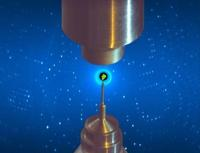Speaker
Description
Double hydrophilic block copolymers can self-assemble in water, leading to scaffolds with strong potential in favor of controlled encapsulation of pharmaceutics. We recently demonstrated that thermoresponsive double hydrophilic poly(N-isopropylacrylamide)-block-poly(oligo ethylene glycol methyl ether acrylate) (PNIPAM-b-POEGA) block copolymer self-assemblies in water can successfully encapsulate indomethacin, a hydrophobic anti-inflammatory drug. By complementing small angle neutron scattering (SANS) with Fourier transform infrared (FTIR) spectroscopy measurements, we explore the influence of temperature as external stimulus and polymer block length asymmetry on chemical bond vibrations and nanoscale assemblies of PNIPAM-b-POEGA block copolymers in aqueous solutions. By SANS, we identify transformations from spheres to fractal core-shell morphologies in the asymmetric block copolymer with the largest PNIPAM block length, while core-shell morphologies are formed for the symmetric diblock copolymer. For both symmetric and asymmetric systems, the evolution of the amide I band upon heating reflects that solvent-polymer interactions are still favorable even at the highest temperatures. Moreover, our results suggest that double hydrophilicity correlates to absence of critical behavior in the vicinity of the cloud point.

